The PSVR 2 is light. Surprisingly light. If there’s one thing that immediately hits me when trying on the PlayStation VR 2 – Sony’s upcoming immersive headset for its still hard-to-buy PlayStation 5 – it’s that compared with the popular Meta Quest 2, it feels like barely anything at all.
The other big thing I notice comes later. Riding down a river through sun-dappled trees in the world of Horizon Call of the Mountain, as I see a massive, brachiosaurus-size Tallneck march its mechanical robot legs over me, my hand moves past dangling plants. I feel them brush against me, lightly. The vibrating haptics on the PSVR 2 Sense controllers feel so subtle, sometimes I don’t recognize them. But the rumblings of the Tallneck don’t just rumble through my hands – I feel it all around my head too. This headset has helmet haptics.
My first demo of the PSVR 2. It arrives in 2023.
James Martin/CNET
At Sony’s PlayStation headquarters in San Mateo, California, I got a full-day look at a headset I’d been waiting to try for over a year.
Sony’s first PlayStation VR debuted in 2016, the same year the HTC Vive and Oculus Rift arrived. Next year could end up being a similarly big one for VR, with Meta prepping new consumer headsets (following a pro model expected in late 2022), and Apple’s long-expected headset. The PlayStation VR 2 is right up there among the contenders if you already have a PlayStation 5.
We still don’t know the price of the PlayStation VR 2, or its specific release date beyond “early 2023,” or what all the launch games will be. But I did get to play four games and try the headset on for hours over the course of a day, and I came away impressed.
The headset
The PSVR 2 isn’t a self-contained, standalone device like the Quest 2. Instead, it tethers to the PlayStation 5 with a USB-C cable. That may turn some people off, but it’s still standard-issue for PC VR gaming. The PSVR 2’s simpler, one-cable setup is far easier than the bulkier breakout box of the original PSVR, and it doesn’t need any extra tracking cameras: Four in-headset cameras enable full room walkabouts, as long as the cable’s long enough. There’s passthrough black-and-white video of the room around me, too, much like the Quest has.
The visor-like headset attaches similarly to the first PSVR, with the back pulling out when you press a button to fit over your head, then tightening with a small knob on the back. The display is surrounded by a rubbery shield that blocks light. My wide glasses, which don’t fit easily in a Quest 2, worked just fine with the PSVR 2.
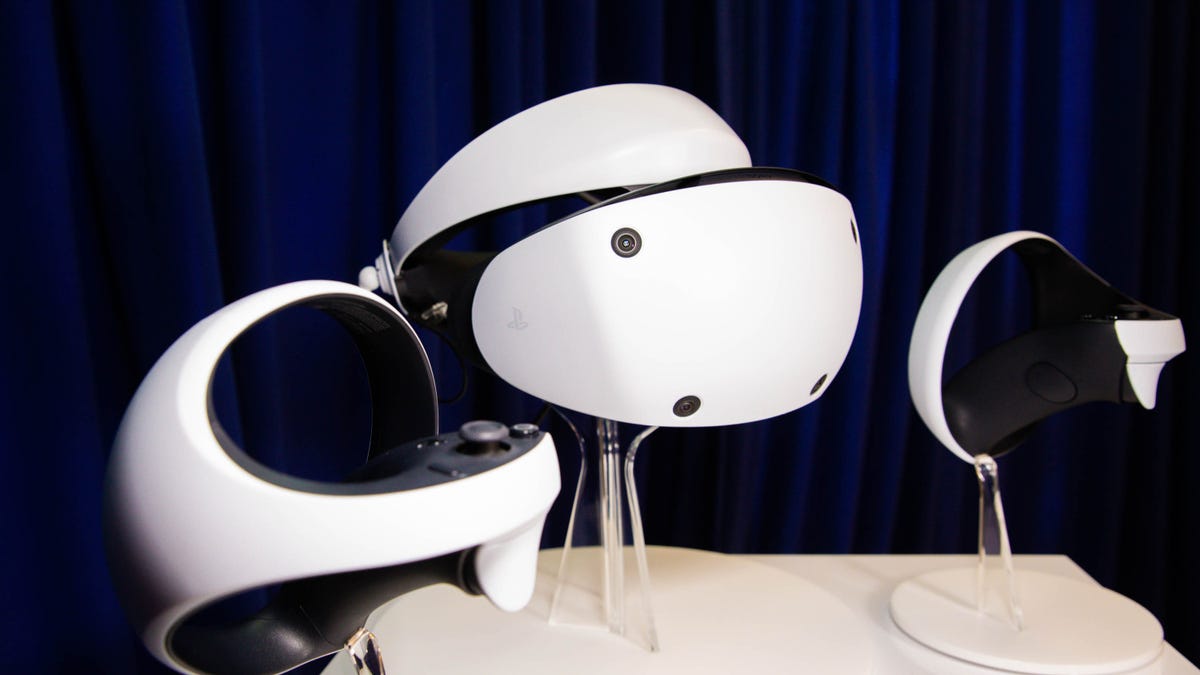
The PSVR 2 headset next to its Sense controllers. Familiar headset design, but it feels light and compact to wear.
James Martin/CNET
At 110 degrees, the OLED display has a wider field of view than the Quest 2, and the field of view looks less like a porthole from the inside. The display is vivid, too: Blacks are truly black, and the HDR effects create bold contrasts between bright sunlight and shady corners. Games I played showed off surprising levels of detail when I looked closely at objects and textures. The 2,000×2,040-pixel per eye display is higher resolution than the Quest 2, but also, the PlayStation 5’s graphics capability is very high.
This headset also features foveated rendering using eye tracking. Foveated rendering is a technique where only the things in the middle of where your eye is looking are rendered in the sharpest detail. It mirrors how our eyes actually work, to some degree, and can squeeze better graphics performance by reducing the workload on the processor. Basically, it meant the games I played looked really, really nice.
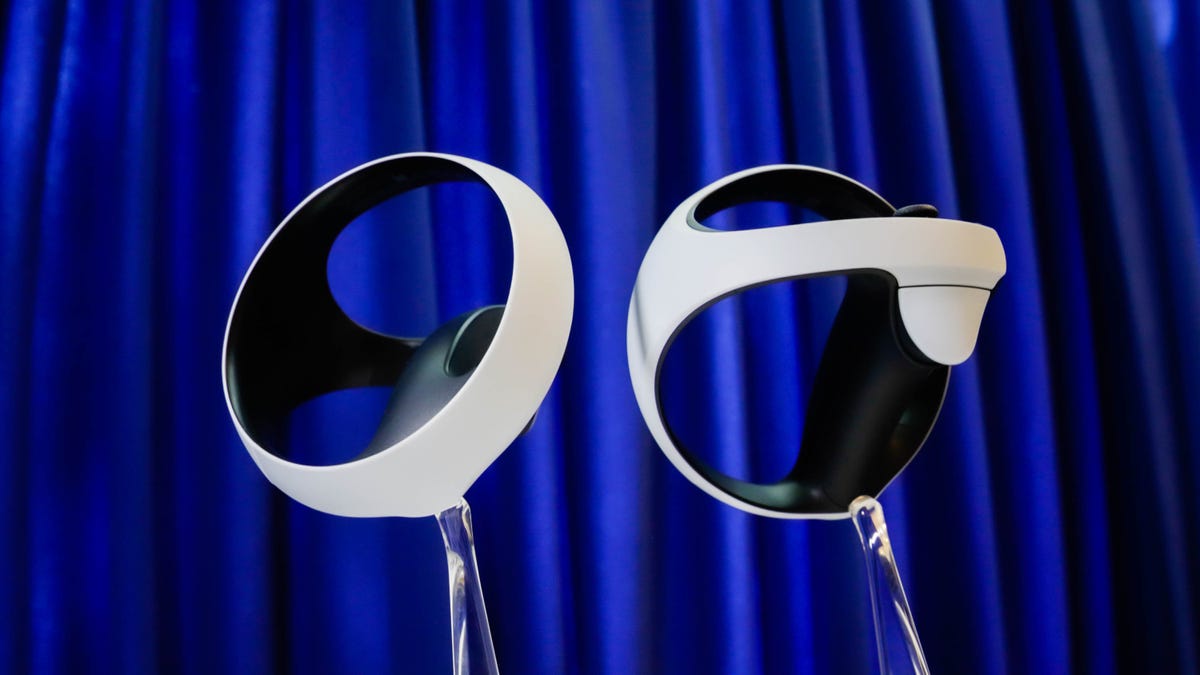
The Sense controllers are lovely.
James Martin/CNET
The Sense controllers
Sony has finally made a pair of real VR controllers. It only took six years. They also might be my favorite VR controllers right now.
The 2016 PSVR borrowed older PlayStation Move controllers that lacked analog sticks and felt primitive compared with other VR gear, but the PSVR 2’s controllers, just called Sense, have a design borrowed from newer input devices like the Oculus Touch. An analog stick and two buttons line each one, in a smaller layout than the way things are placed on the Quest 2 controllers. Triggers are on each, plus secondary clickable grip buttons below that.
The controllers feel light too: The rings that are part of their design sit back behind my hands, and I feel like they float around my knuckles. The grips become things I grab or let go of. Sometimes the controllers feel like Valve’s Index “knuckle” controllers, that way, where I start gripping my entire hand versus just three fingers to do things on the Quest 2. When holding weapons or climbing VR cliffs, it feels convincing.
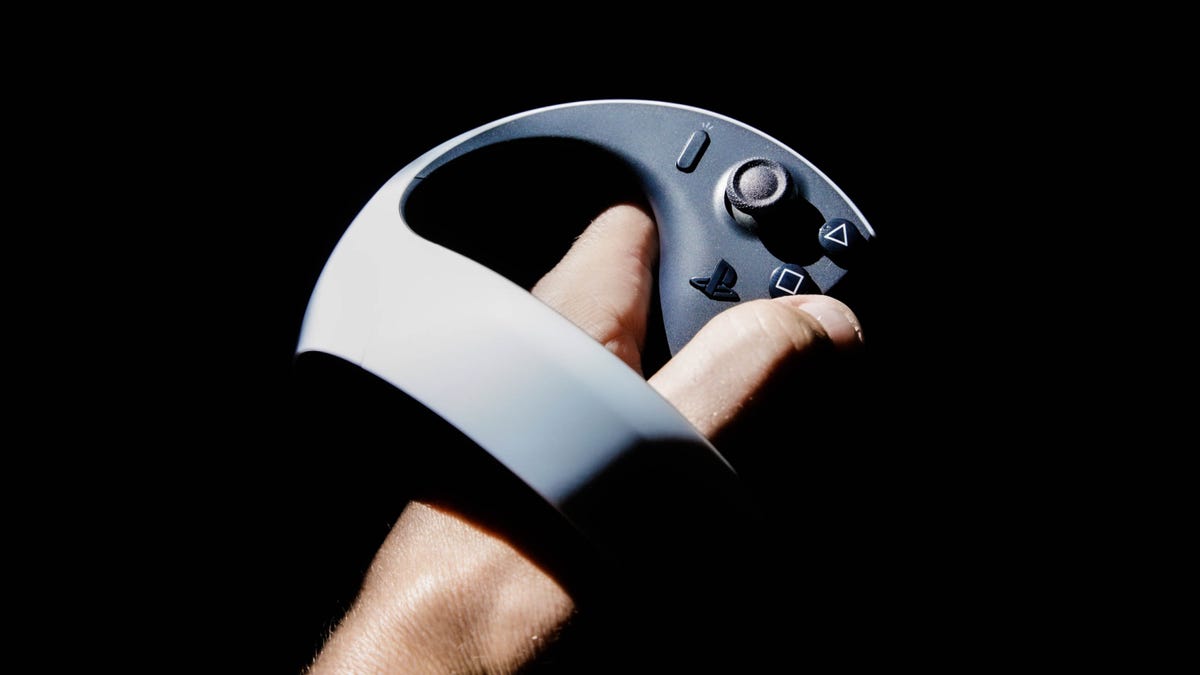
The controllers fit comfortably, and they melt away a bit when playing.
James Martin/CNET
But the killer part is the haptics. Sony has adopted the same rich haptics tech on the PS5 DualSense controllers, which can register small taps, rippling rumblings and all sorts of convincing vibrations that are far more advanced than the generic buzzes of the Quest 2 controllers. The triggers also have feedback – again, based on the adaptive trigger tech on the DualSense. Pressing a trigger on different weapons in Star Wars: Tales From the Galaxy’s Edge means some have resistance early on, and others feel easier to pull. Some have kickback you can feel in the trigger and the haptics. Grabbing ledges can start to feel slippery or firm. Through all the games I played, I realized this was where VR haptics needed to be from now on. It’s set the table.
The games
I played four games over my full day with the PlayStation VR 2. Three of them were sequels, ports or adaptations of existing games. The other was a brand-new game based on a known property (Sony’s Horizon games). None of the games reinvented VR in any massive way, and in a lot of ways the controls for most of the games matched familiar interfaces I’ve gotten used to in other games over the years. The PSVR 2 isn’t expected to arrive until early 2023, so I’m sure other games will emerge. What these demos offered, more than anything, was a chance to see how Sony’s new headset and controllers compare with what I’ve played before.
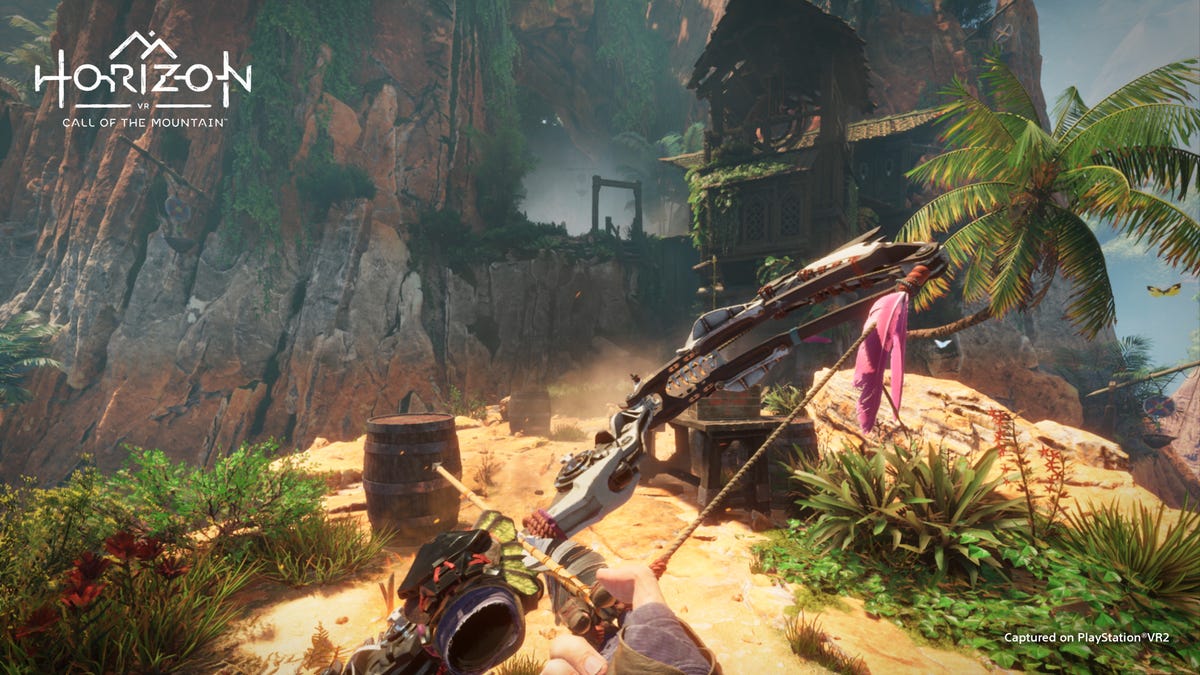
Bows and arrows feel great in Horizon: Call of the Mountain.
Sony Interactive Entertainment
Horizon: Call of the Mountain, Guerilla/Sony
Sony’s flagship exclusive PSVR 2 game was announced earlier this year. Set in the same far-future universe as Horizon Zero Dawn and Horizon Forbidden West, this one’s a standalone game that’s made for newcomers to enjoy, too, with some overlap with the PS4/PS5 games.
The demo put me on a boat heading on a Jurassic Park-like river ride past familiar Horizon creatures: raptor-like Watchers, and a massive lumbering Tallneck that towers overhead. The game then becomes about wandering around wilderness camps, climbing cliffs by grabbing ledges in a similar way to the VR game The Climb, and shooting arrows at enemies and secret targets with a bow and arrow. The landscapes are gorgeous, colors vivid. I notice the impressive controller feedback when climbing ledges and shooting arrows, and the rumbling headset haptics kick off when large creatures move around me. The sensation I get is massive and theatrical, and while the demo ends sooner than I’d like, Call of the Mountain is clearly an experience to get lost in.
According to the developers, eye tracking is used subtly later on in the game (perhaps to allow characters to make eye contact with me), but the advantages of eye tracking only show up otherwise to create enhanced graphics with foveated rendering – something the other games I played also have in common.
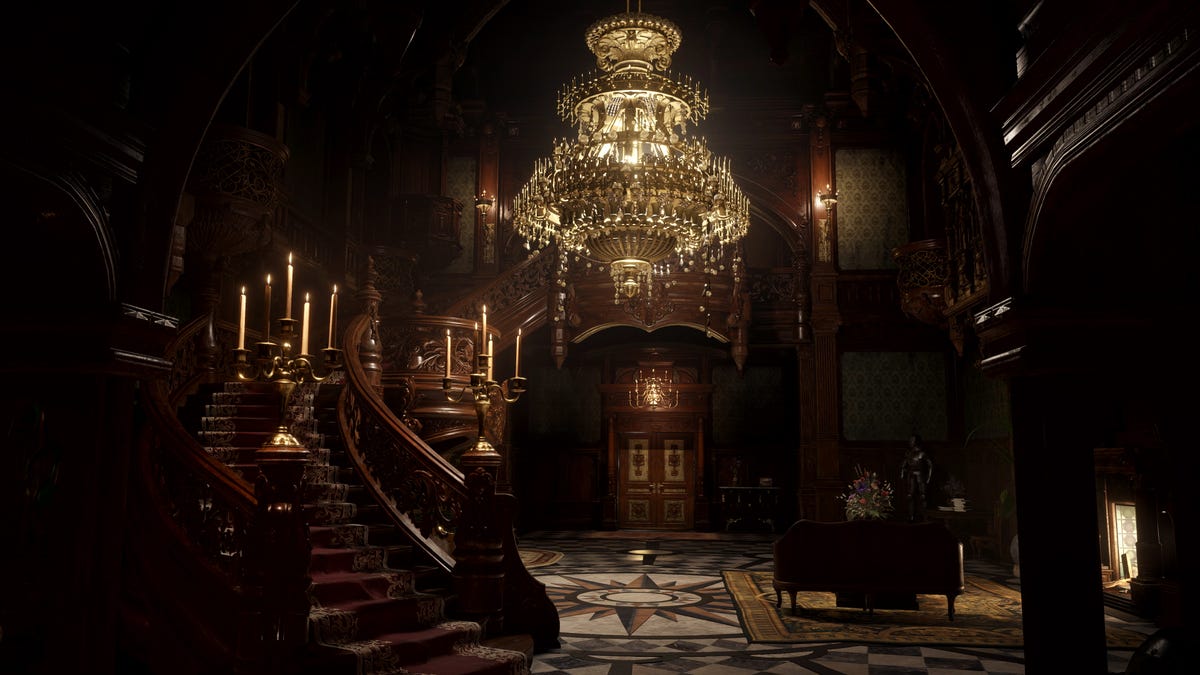
Environments in Resident Evil: Village really looked this good in VR.
Capcom
Resident Evil Village, Capcom
I kept away from Resident Evil 7 in VR because I was terrified of it. I’ve since played Resident Evil 4 on the Quest 2, and gotten less worried about VR jump scares. I also never played Resident Evil Village before my VR demo experience (sorry!), but Capcom’s PSVR 2-exclusive adaptation truly feels like a video game fully adapted to VR without any loss. I was particularly impressed, again, by the headset’s graphics output. Environments look vast and moody, but full of detail. Entering the tremendous castle, I’m immediately drawn to the paintings on the wall and the carvings on doors. Lighting from nearby windows or candle-lit halls looks convincing and rich. I meet Lady Dimitrescu, who leans over and sucks on my hand in a way that makes me cringe.
The scale of the world works wonderfully, and it comes across like immersive theater, some sort of Sleep No More horror experience. Sometimes the game’s motion tracking doesn’t line up with my body (there were a few game glitches in my demo), but the speed of the gameplay and the richness of the graphics gave this game an almost non-VR feel. I stopped thinking about the controllers, too: It’s almost like they melted away, which was a credit to the design.
Also, I panic when a bunch of freaky monsters surround me, and I just stab them relentlessly before realizing I could have been reloading my pistol this whole time.
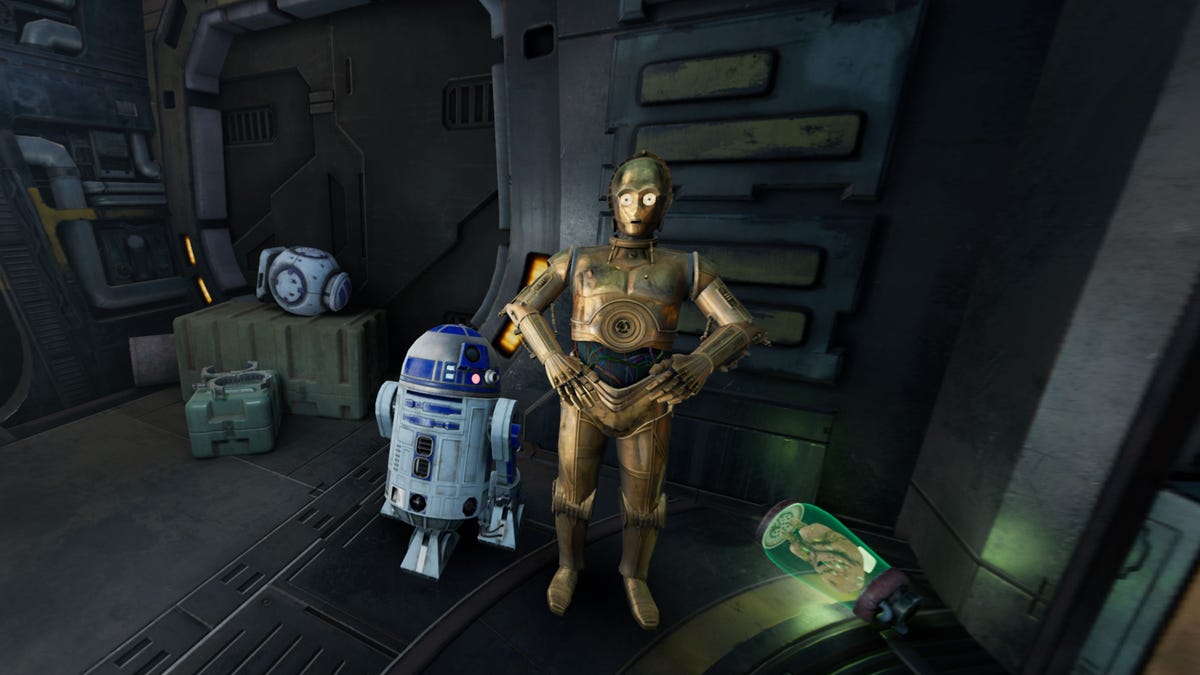
Tales From the Galaxy’s Edge has a graphics update and much better haptics.
ILMxLab
Star Wars: Tales from the Galaxy’s Edge, ILMxLab
One of my favorite games for the Meta Quest 2 is being ported over to PlayStation VR 2. This was a surprise game, but ILMxLab did the same with Star Wars: Vader Immortal a few years ago. It’s a shooter with interludes at a cantina, all of it set on Batuu (the same world that Disney’s Galaxy’s Edge theme park exists in). The game’s graphics and controller haptics have been upgraded, and besides all the characters looking far more vivid, all the weapons now have an uncanny sense of vibrational realism. I notice that small blasters have different-feeling triggers and recoil than a large pulsing shotgun. I could identify weapons from how they feel via haptics.
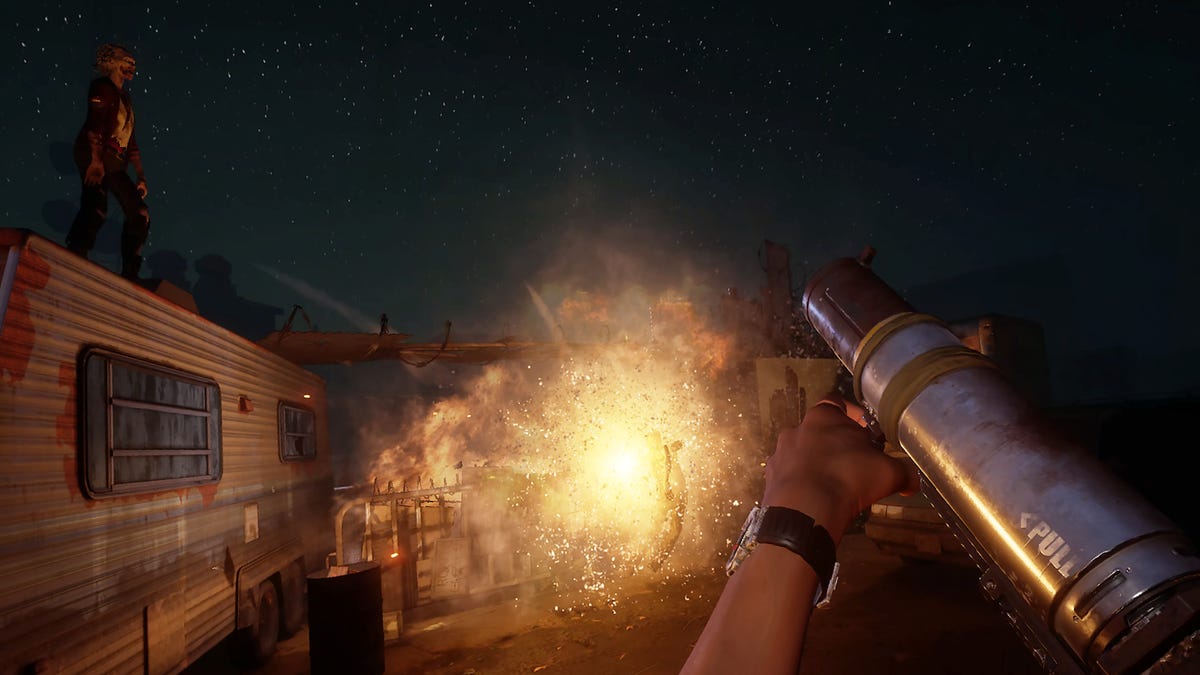
The action gets intense.
Skydance
The Walking Dead: Saints and Sinners Chapter 2, Skydance
Again, one of my favorite Quest games makes an appearance on PSVR 2. This new chapter isn’t available anywhere yet, but the gameplay (lots of zombies, lots of weapons to load up and so many areas of my body to pin flashlights and tools and other things) remains the same as other versions. Again, it’s the subtle haptics and the improved graphics that make the biggest impression.
A few drawbacks: Tethering, tracking
The PSVR 2 does have a single USB-C cable that tethers it to the PS5, and it’s unfortunate. But I’ve had the same tether when playing PC games in VR. At least it’s just one cable, and even though it sometimes wrapped around me when I turned a lot in some active games, it was bearable.
One other thing I noticed a handful of times was the headset lost tracking: either my headset, or the controllers. I’m playing on a very early version of the hardware, and a camera person filming me at close range while playing may have thrown off the in-headset tracking cameras. Still, any loss of tracking isn’t ideal.
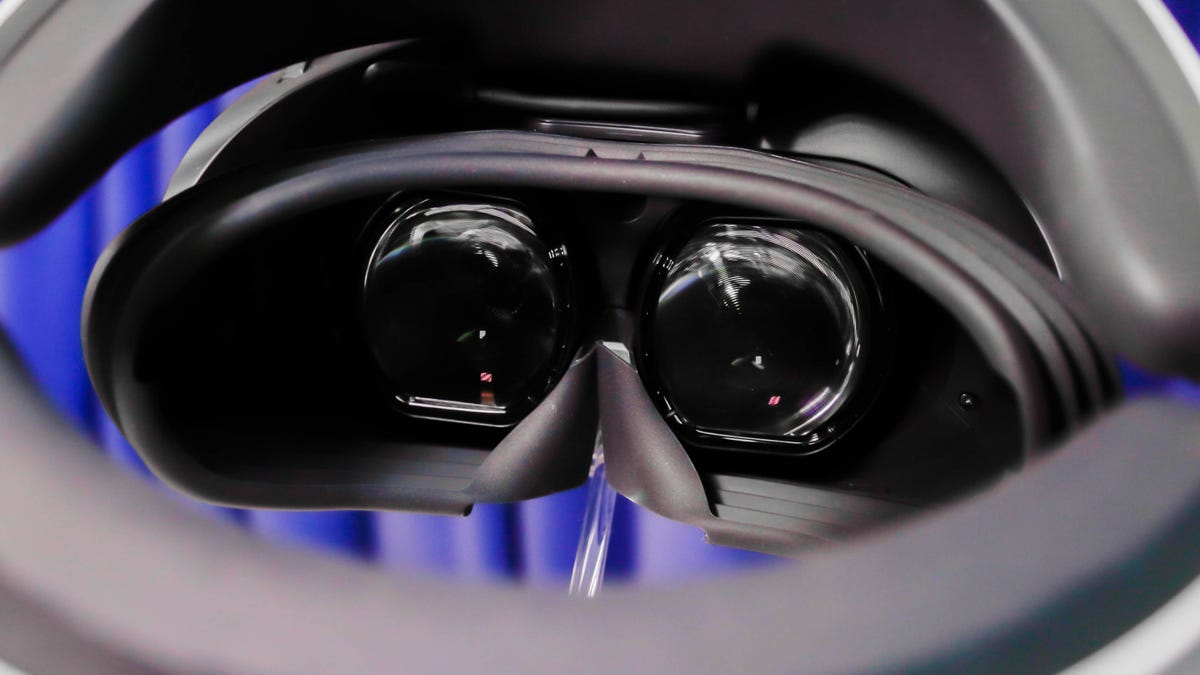
The PSVR 2 has eye tracking. How much will games use it?
James Martin/CNET
Will any games truly take advantage of eye tracking?
The games I tried didn’t really use eye tracking in any unique ways during my demos, which was a little surprising. That might be because many of these games are being adapted from VR platforms that don’t have eye tracking. The PSVR 2 is the first mainstream headset with the feature, although many more may be on the way.
There are possibilities for eye tracking to improve game controls, allowing your eyes to lock in on an object and target it without needing to move your head or the controller. Eye contact with characters could provide a theatrical level of intimacy. Games could also start recording heat maps of your attention and become better able to suggest ideas or hints based on where it knows you’re not looking.
Talking to some of the developers during my day of demos, they all seemed excited by the possibilities. Maybe, as eye tracking becomes more of a norm for VR and AR, more games will add support for it. I didn’t get to see enough yet to know how big an impact it could make.
2023 can’t come soon enough
The PlayStation VR 2 doesn’t have a price yet, or an official release date, or a larger list of launch games. Even though this isn’t a standalone headset, it’s clearly the VR experience I’ve always wanted on a PlayStation. The new controllers and improved and advanced haptics and triggers alone push this hardware into new gaming territory. I much prefer the lighter-weight, larger field-of-view, higher-res, OLED display-equipped PSVR 2 headset to the Quest 2. While the Quest 2 is still the best self-contained VR system around, the PSVR 2 looks like it could be the destination for a whole new wave of more impressive VR games.
All I know is I want to play more. When I got home after my weekend in California, I saw my unplugged pile of PlayStation VR cables sitting on my desk. I look at the old, heavy headset, and the ancient controllers. The PlayStation VR 2, in retrospect, feels even more amazing in comparison.

Be the first to comment